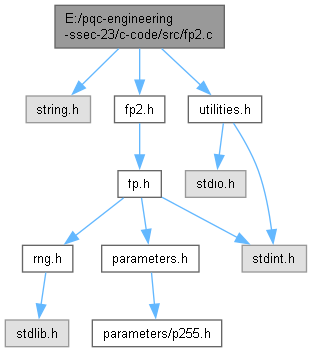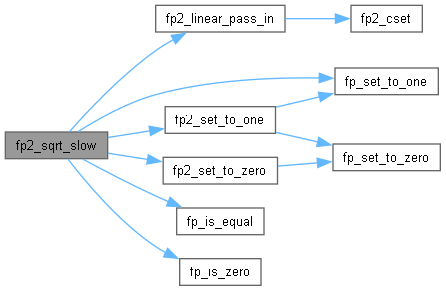
Go to the source code of this file.
Function Documentation
◆ fp2_add()
◆ fp2_batchinv()
◆ fp2_conj()
◆ fp2_copy()
◆ fp2_cset()
Definition at line 81 of file fp2.c.
References FIELD_64BITS_WORDS, i, fp2_t::im, and fp2_t::re.
Referenced by fp2_linear_pass_in(), and fp2_linear_pass_out().

◆ fp2_cswap()
◆ fp2_curt()
Definition at line 399 of file fp2.c.
References CUBE_ROOT_EXPONENT_BITS, FIELD_64BITS_WORDS, fp2_copy, fp2_mul, fp2_set_to_one(), fp2_sqr, i, and j.
Referenced by isogeny_walks_3(), and isogeny_walks_get_points_3().


◆ fp2_element_from_bytes()
Definition at line 140 of file fp2.c.
References FIELD_64BITS_WORDS, FIELD_BYTES, and fp2_to_mont().

◆ fp2_from_mont()
Definition at line 119 of file fp2.c.
References fp_from_mont(), fp2_t::im, and fp2_t::re.
Referenced by fp2_to_bytes().


◆ fp2_half()
Definition at line 107 of file fp2.c.
References fp_half(), fp2_t::im, and fp2_t::re.
Referenced by isogeny_walks_2(), isogeny_walks_2_slow(), and isogeny_walks_get_points_3().


◆ fp2_inv()
◆ fp2_is_equal()
Definition at line 154 of file fp2.c.
References fp_is_equal(), fp2_t::im, and fp2_t::re.

◆ fp2_is_square()
◆ fp2_is_zero()
Definition at line 149 of file fp2.c.
References fp_is_zero(), fp2_t::im, and fp2_t::re.
Referenced by fp2_locate_zero().


◆ fp2_linear_pass_in()
| void fp2_linear_pass_in | ( | fp2_t * | output, |
| const fp2_t * | input, | ||
| uint8_t | input_length, | ||
| uint8_t | input_index | ||
| ) |
Definition at line 159 of file fp2.c.
References fp2_cset(), and i.
Referenced by fp2_sqrt_slow(), isogeny_walks_2(), isogeny_walks_2_slow(), and isogeny_walks_3().


◆ fp2_linear_pass_out()
Definition at line 170 of file fp2.c.
References fp2_cset(), and i.

◆ fp2_locate_zero()
Definition at line 181 of file fp2.c.
References fp2_is_zero(), and i.

◆ fp2_mul()
◆ fp2_neg()
◆ fp2_set_to_one()
Definition at line 49 of file fp2.c.
References fp_set_to_one(), and fp_set_to_zero().
Referenced by fp2_curt(), fp2_sqrt_slow(), isogeny_walks_2(), isogeny_walks_2_slow(), isogeny_walks_3(), isogeny_walks_from_montgomery_model_2(), isogeny_walks_from_montgomery_model_3(), isogeny_walks_get_previous_step_2(), and main().


◆ fp2_set_to_zero()
Definition at line 54 of file fp2.c.
References fp_set_to_zero().
Referenced by cgl_hash_digest_2(), cgl_hash_digest_3(), fp2_sqrt_slow(), and main().


◆ fp2_sqr()
◆ fp2_sqrt_fast()
Definition at line 333 of file fp2.c.
References constant_time_conditional_mov(), FIELD_64BITS_WORDS, fp_add, fp_copy, fp_is_equal(), fp_mul, fp_neg(), fp_set_to_one(), fp_set_to_zero(), fp_sqr, i, fp2_t::im, j, and fp2_t::re.
Referenced by isogeny_walks_2().


◆ fp2_sqrt_slow()
Definition at line 283 of file fp2.c.
References FIELD_64BITS_WORDS, fp2_add, fp2_copy, fp2_linear_pass_in(), fp2_mul, fp2_set_to_one(), fp2_set_to_zero(), fp2_sqr, fp_is_equal(), fp_is_zero(), fp_set_to_one(), fp_sub, i, fp2_t::im, j, fp2_t::re, and SQUARE_ROOT_EXPONENT_BITS.
Referenced by isogeny_walks_2_slow(), and isogeny_walks_get_points_3().


◆ fp2_sub()
◆ fp2_to_bytes()
Definition at line 131 of file fp2.c.
References FIELD_BYTES, and fp2_from_mont().

◆ fp2_to_mont()
Definition at line 113 of file fp2.c.
References fp_to_mont(), fp2_t::im, and fp2_t::re.
Referenced by fp2_element_from_bytes().




